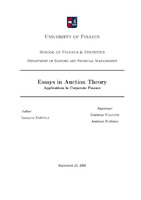Essays in auction theory with applications in corporate finance

Doctoral Thesis
Συγγραφέας
Zarpala, Lamprini
Ζαρπαλά, Λαμπρινή
Ημερομηνία
2021-09-22Επιβλέπων
Βολιώτης, ΔημήτριοςVoliotis, Dimitrios
Προβολή/
Λέξεις κλειδιά
Bond market ; Auctions ; Market structure ; Market design ; Risk limits ; Budget limits ; Two-round auctions ; Affliated signals ; Pricipal blind bidding ; Package auction ; VCG payments ; Portfolio tradingΠερίληψη
This Ph.D. thesis is a collection of three publishable papers with a significant contribution to auction theory and its corporate finance applications. Each chapter of this thesis addresses each paper separately, apart from Chapter 1. In Chapter 1, we introduce and explain some essential auction-theoretic toolkits for the following chapters' analysis and discuss some seminal papers we used as a grounding base of our research.
Chapter 2 investigates how uniform-price auctions can be used for the pricing of corporate bonds. In order to have a realistic approach, we incorporate the investment mandates and the budget limits on the bidding strategies under the presence of a
secondary market. To our knowledge, we are the first to address all these factors in one model and result in some interesting results presented both in section 2.4 and Chapter 5.
The next chapters examine the auction designs of portfolio trading. In Chapter 3 we propose a two-stage auction design for the pricing of blind portfolios - a basket of unknown securities auctioned at a pre-determined execution price. The mechanism
allows information release at the interim and this feature not only can reduce the asset managers' liquidation costs but also eliminate brokers' "winners' curse".
In Chapter 4 we design a two-stage auction for a divisible portfolio auctioned either as parts or as a whole. Again the two-round setup admits an information release at the interim, which may offset the "winner's curse". Our main novelty is a new pricing
rule for a core-selecting auction that extends the current Nearest-VCG in a dynamic two-round setup and can mitigate free-riding incentives. The last chapter summarizes the results from previous chapters and concludes.


